| Revision as of 20:15, 18 June 2013 editBazza 7 (talk | contribs)Extended confirmed users, Template editors16,460 edits Undid revision 560466691 by 75.87.151.38 (talk) Lasagne in English (reference added)← Previous edit | Revision as of 11:58, 19 June 2013 edit undoJuzumaru (talk | contribs)798 editsNo edit summaryNext edit → | ||
| Line 9: | Line 9: | ||
| ] pasta names often end with the ] ] ]es ''-ini'', ''-elli'', ''-illi'', ''-etti'' or the feminine plurals ''-ine'', ''-elle'' etc., all conveying the sense of "little"; or with ''-oni'', ''-one'', meaning "large". Many other suffixes like ''-otti'' ("largish") and ''-acci'' ("rough", "badly made") may occur, too. In Italian, all pasta type names are plural. | ] pasta names often end with the ] ] ]es ''-ini'', ''-elli'', ''-illi'', ''-etti'' or the feminine plurals ''-ine'', ''-elle'' etc., all conveying the sense of "little"; or with ''-oni'', ''-one'', meaning "large". Many other suffixes like ''-otti'' ("largish") and ''-acci'' ("rough", "badly made") may occur, too. In Italian, all pasta type names are plural. | ||
| East Asian ]s originated in China and spread into neighboring countries such as ] and ] ('']'' and '']'', for example, are both of Chinese origin), as well as Southeast Asian countries such as ], the ], ], and ]. | East Asian ]s originated in China and spread into neighboring countries such as ] ('']'') and ] ('']'') , for example, are both of Chinese origin), as well as Southeast Asian countries such as ], the ], ], and ]. | ||
| The dough for East Asian noodles can be made from ], ], ], or ] starch. ], lye, and cereal may also be added to noodles made from ] in order to give the noodles a different color or flavor. ] or ] starch are sometimes added to the flour mixture in low quantities to change the texture and tenderness of the noodles' strands. | The dough for East Asian noodles can be made from ], ], ], or ] starch. ], lye, and cereal may also be added to noodles made from ] in order to give the noodles a different color or flavor. ] or ] starch are sometimes added to the flour mixture in low quantities to change the texture and tenderness of the noodles' strands. | ||
Revision as of 11:58, 19 June 2013
Main articles: Pasta and Chinese noodles

This is a list of pasta, and includes types of pasta from culinary traditions around the world.
Some pasta varieties are uniquely regional and not widely known; some types may have different names in different languages, or sometimes in the same language. For example, the cut rotelle is also called ruote in Italy and "wagon wheels" in the United States. Manufacturers and cooks often invent new shapes of pasta; or may invent new names for old shapes for marketing reasons.
Italian pasta names often end with the masculine plural suffixes -ini, -elli, -illi, -etti or the feminine plurals -ine, -elle etc., all conveying the sense of "little"; or with -oni, -one, meaning "large". Many other suffixes like -otti ("largish") and -acci ("rough", "badly made") may occur, too. In Italian, all pasta type names are plural.
East Asian noodles originated in China and spread into neighboring countries such as Korea (dangmyeon) and Japan (ramen) , for example, are both of Chinese origin), as well as Southeast Asian countries such as Vietnam, the Philippines, Thailand, and Cambodia.
The dough for East Asian noodles can be made from wheat, rice, buckwheat, or mung bean starch. Egg, lye, and cereal may also be added to noodles made from wheat flour in order to give the noodles a different color or flavor. Arrowroot or tapioca starch are sometimes added to the flour mixture in low quantities to change the texture and tenderness of the noodles' strands.
Long noodles
Long noodles may be made by extrusion or rolling and cutting.
| Image | Type | Description | Translation |
|---|---|---|---|
| Barbina | Thin strands often coiled into nests | Little beards | |

|
Bigoli | Thick tubes, often made of buckwheat or wholewheat flour | |

|
Bucatini | A thick spaghetti-like pasta with a hole running through the center. | The name comes from Template:Lang-it, meaning "hole", while bucato means "pierced". |
| Capelli d'angelo | A synonym of capellini, they are coiled into nests | Angel hair | |

|
Capellini | The thinnest type of long pasta | Literally "thin hair" in Italian language |

|
Cu mian - 粗面 Template:Zh icon | Thick-cut noodles made from wheat flour and water, it's a type of Chinese noodle commonly used in the cuisines of northern China. In addition, it may also be found in Hong Kong, as well as in restaurants specializing in northern Chinese cuisine in other parts of China. | Literally "thick noodles" |
| Fedelini | A very thin spahgetti. | Little faithful ones | |

|
Fusilli | Long, thick, corkscrew shaped pasta that may be solid or hollow. Hollow fusilli are also called fusilli bucati. Pictured is fusilli in a pesto sauce. | The word fusilli presumably comes from fuso, as traditionally it is "spun" by pressing and rolling a small rod over each thin strips of pasta to wind them around it in a corkscrew shape, much like a modern Turkish spindle. Long rifles. |

|
Fusilli bucati | Long coiled tubes that are hollow. | Holed rifles |
| Matriciani | Similar to perciatelli, but folded over rather than hollowed out | ||

|
Pellizzoni | Thick spaghetti | Medium twines |

|
Perciatelli | Identical to bucatini. | From perciare "to hollow" |
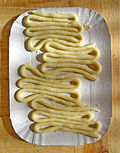
|
Pici | Very thick, long, hand rolled pasta. It originates in the province of Siena in Tuscany; in the Montalcino area it is also referred to as pinci. | |

|
Soba - そば Template:Ja | Thin cut Japanese noodles made from buckwheat. Soba noodles are served either chilled with a dipping sauce, or in hot broth as a noodle soup. It takes three months for buckwheat to be ready for harvest, so it can be harvested four times a year, mainly in spring, summer, and autumn. | |

|
Spaghetti | A long, thin, cylindrical pasta of Italian and Sicilian origin. Spaghetti is made of semolina or flour and water. | "Little strings." Spaghetti is the plural form of the Italian word spaghetto, which is a diminutive of spago, meaning "thin string" or "twine". |

|
Spaghettini | Thin spaghetti | Small little twines |
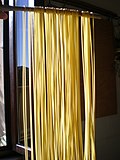
|
Spaghettoni | A spaghetti that is extra thick or extra long. | |

|
Udon - うどん Template:Ja | Thick-cut noodles made from wheat flour. Udon is usually served hot as noodle soup in its simplest form as kake udon, in a mildly flavoured broth called kakejiru which is made of dashi, soy sauce (shōyu), and mirin. The flavor of broth and topping vary from region to region. | |
| Vermicelli | A traditional pasta round that is thicker than spaghetti. (refers in U.S. to a style thinner than spaghetti) | Worms | |
| Vermicelloni | Thick vermicelli | Large little worms | |

|
Ziti | Long, narrow hose-like tubes sized smaller than rigatoni but larger than mezzani. The addition of the word rigati (e.g. ziti rigati) denotes lines or ridges on the pasta's surface. | Zito is Italian for "bridegroom." (Ziti is plural). |
| Zitoni | Wider version of Ziti | Large ziti |
Ribbon-cut noodles
Ribbon style noodles are often rolled flat and then cut. This can be done by hand or mechanically.
| Image | Type | Description | Translation |
|---|---|---|---|

|
Bavette | Narrower version of tagliatelle | Little drip-thread |
| Bavettine | Narrower version of bavette | ||

|
Biángbiáng noodles - 油泼扯面 Template:Zh icon | Very wide ribbon cut rice noodles | |
| Ciriole | Thicker version of chitarra | ||
| Fettuce | Wider version of fettuccine | Little slices | |

|
Fettuccine | Ribbon of pasta approximately 6.5 millimeters wide | Little slices |
| Fettucelle | Narrower version of fettuccine | Little slices | |
| Lagane | Wide noodles | ||

|
Lasagne | Very wide noodles that often have fluted edges | Cooking pot |

|
Lasagnette | Narrower version of lasagne | Little lasagne |
| Lasagnotte | Longer version of lasagne | Bigger lasagne | |
| Linguettine | Narrower version of linguine | Little tongues | |

|
Linguine | Flattened spaghetti | Little tongues |
| Mafalde | Short rectangular ribbons | Named in honor of Princess Mafalda of Savoy | |

|
Mafaldine | Long ribbons with ruffled sides | Little mafalde |

|
Pappardelle | Thick flat ribbon | |
| Pillus | Very thin ribbons | ||

|
Pizzoccheri | A type of short tagliatelle, a flat ribbon pasta, made with 80% buckwheat flour and 20% wheat flour. | |
| Sagnarelli | Rectangular ribbons with fluted edges | ||
| Scialatelli or scilatielli | Homemade long spaghetti with a twisted long spiral | ||

|
Shahe fen - 沙河粉 Template:Zh icon | Ribbon cut rice noodles | Sen yai Template:Th icon, kwetiau Template:Id icon |

|
Spaghetti alla chitarra | Similar to spaghetti, except square rather than round, and made of egg in addition to flour | Named after the guitar-like device used to cut the pasta, which has a wooden frame strung with metal wires, sheets of pasta are pressed down onto the device, and then the wires are "strummed" so the slivers of pasta fall through. |
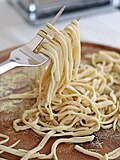
|
Stringozzi | Similar to shoelaces | Shoestring-like |
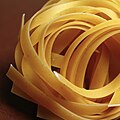
|
Tagliatelle | Ribbon, generally narrower than fettuccine | From the Italian tagliare, meaning "to cut" |
| Taglierini | Thinner version of tagliatelle | From the Italian tagliare, meaning "to cut" | |

|
Trenette | Thin ribbon ridged on one side | |
| Tripoline | Thick ribbon ridged on one side |
Short-cut extruded pasta
| Image | Type | Description | Translation |
|---|---|---|---|
| Calamarata | Wide ring shaped pasta | Squid-like | |
| Calamaretti | Little squids | ||

|
Cannelloni | Large stuffable cylindrical (tube) pasta, generally served baked with a filling and covered by a sauce. | (Template:Lang-it) |

|
Cavatappi | Corkscrew-shaped macaroni | Corkscrews |

|
Cellentani | See Cavatappi | |
| Chifferi | Short and wide macaroni | ||

|
Ditalini | Short tubes | Small thimbles |
| Elicoidali | Slightly ribbed tube pasta, the ribs are corked as opposed to those on rigatoni | Helicoidal ones | |
| Fagioloni | Short narrow tube | Large beans | |

|
Fideuà | Short and thin tubes | Fideuá is not really a type of pasta but is a Spanish dish similar to paella but made with pasta instead of rice. |
| Garganelli | Egg pasta in a square shape rolled into a tube | ||

|
Gemelli | A single S-shaped strand of pasta twisted in a loose spiral | The name derives from the Italian for twins. |

|
Gomiti | Bent tubes | Elbows |
| Maccheroncelli | Hollow tube-shaped pasta that is slightly smaller than a pencil in thickness. | Small maccheroni | |
| Maltagliati | A short and wide egg pasta with irregular or diagonally cut ends, it is available throughout Italy and is prominent in some regional Italian cuisines. | Roughly cut | |

|
Manicotti | Large stuffable ridged tubes | |
| Marziani | Short spirals | Martians (refers to the antennae of cartoon martians) | |
| Mezzani pasta | Short curved tube | Half-size ones | |
| Mezze penne | Short version of penne | Half-pens | |
| Mezzi bombardoni | Wide short tubes | Half bombards | |

|
Mostaccioli | Similar to penne but without ridges. Also called penne lisce or "smooth penne" | Moustache-like things |

|
Paccheri | Large tube pasta that may be prepared with a sauce atop them or stuffed with ingredients. | "Slaps." The name has been ascribed to a slapping sound they may make when eaten. |
| Pasta al ceppo | A sheet pasta that is similar in shape to a cinnamon stick. | Log-type pasta | |

|
Penne | Medium length tubes with ridges, cut diagonally at both ends | Pens (after a quill pen) |

|
Penne rigate | Penne with ridged sides | Lined pens |
| Penne lisce | Penne with smooth sides | Smooth pens | |
| Penne zita | Wider version of penne | ||
| Pennette | Short thin version of penne | Little pens | |
| Pennoni | A wider and thicker version of penne. It is a tube pasta with a diaganol cut on both ends. | Pennants | |
| Rigatoncini | Smaller version of rigatoni | Small large lined ones | |
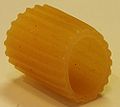
|
Rigatoni | Medium-Large tube with square-cut ends, sometimes slightly curved | Large lined ones |

|
Rotini | Related to fusilli, but has a tighter helix, i.e. with a smaller pitch | Helix- or corkscrew-shaped pasta |

|
Sagne 'ncannulate | Long tube formed of twisted ribbon | |
| Spirali | A tube which spirals round | Spirals | |
| Spiralini | More tightly-coiled fusilli | Little spirals | |
| Trenne | Penne shaped as a triangle | ||
| Trennette | Smaller version of trenne | ||

|
Tortiglioni | Narrower rigatoni | Spirals |
| Tuffoli | Ridged rigatoni |
Decorative shapes
| Image | Type | Description | Translation |
|---|---|---|---|

|
Campanelle | Flattened bell-shaped pasta with a frilly edge on one end | Little bells |

|
Capunti | Short convex ovals resembling an open empty pea pod | |

|
Casarecce | Short lengths rolled into a S shape | From casereccio meaning homemade |

|
Cavatelli | Short, solid lengths | From the verb cavare meaning to hollow |

|
Cencioni | Petal shaped, slightly curved with rough convex side | Large rags |

|
Conchiglie | Seashell shaped | Shells |

|
Conchiglioni | Large, stuffable seashell shaped | Large shells |

|
Corzetti | Flat figure-eight stamped | |

|
Creste di galli | Short, curved and ruffled | Cock's comb |

|
Croxetti | Flat coin-shaped discs stamped with coats of arms | Little crosses |

|
Farfalle | Bow tie or butterfly shaped | "Butterflies" |
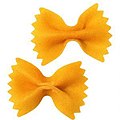
|
Farfalloni | Larger bow ties | Large butterflies |

|
Fiorentine | Grooved cut tubes | Florentine |

|
Fiori | Shaped like a flower | Flowers |

|
Foglie d'ulivo | Shaped like an olive leaf | Olive leaves |

|
Gigli | Cone or flower shaped | Lilies |

|
Gramigna | Short curled lengths of pasta | Infesting weed, esp. scutch-grass |

|
Lanterne | Curved ridges | Lanterns |

|
Lumache | Snailshell-shaped pieces | Snails |

|
Lumaconi | Large snailshell-shaped pieces | Large snails |
| Maltagliati | Flat roughly cut triangles | Badly cut | |
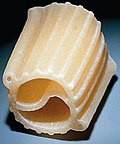
|
Mandala | Designed by Philippe Starck in 1987 for French pasta maker Panzani, intended to compensate for overcooking. | A reference to mandalas. |
| Marille | Designed by Giorgetto Giugiaro in 1983 - like a rolling ocean wave in cross-section with internal rugosities, but unsuccessful and no longer produced. | From mare, meaning "sea" | |

|
Orecchiette | Bowl- or ear-shaped pasta | Little ears |

|
Pipe | Very similar to Lumaconi but has lines running the length of it. | Smoking pipes |

|
Quadrefiore | Square with rippled edges | From quadro ("square") and fiore ("flower") |

|
Radiatori | Shaped like radiators, they were created in the 1960s, by an industrial designer. They are often used in similar dishes as rotelle or fusilli, because their shape works well with thicker sauces. | Radiator |

|
Ricciolini | Short wide noodles with a 90-degree twist | Little curls |

|
Ricciutelle | Short spiralled noodles | Little curls |

|
Rotelle | Wagon wheel-shaped pasta | Little wheels |

|
Rotini | 2-edged spiral, tightly wound, some vendors and brands are 3-edged and sold as rotini | |

|
Sorprese | Bell shaped pasta with a crease on one side and has a ruffled edge | Surprise |

|
Sorprese Lisce | Bell shaped pasta with a crease on one side and has a ruffled edge (A larger version of Sorprese) | Smooth surprise |

|
Strozzapreti | Rolled across their width | Priest-chokers or priest-stranglers |

|
Torchio | Torch shaped | Winepress |

|
Trofie | Thin twisted pasta |
Minute pasta
These are small types of pasta.
| Image | Type | Description | Translation |
|---|---|---|---|

|
Acini di pepe | Bead-like pasta | Peppercorns |

|
Alfabeto | Pasta shaped as letters of the alphabet | Alphabet |

|
Anelli | Small rings of pasta (not to be confused with Calamaretti) | Rings |

|
Anellini | Smaller version of anelli | Little rings |

|
Couscous | Grain-like pasta, most common in North Africa and Europe (especially France), increasingly common in Asia and North America | |

|
Conchigliette | Small shell-shaped pasta | Little shells |

|
Corallini | Small short tubes of pasta | Little corals |
| Ditali | Small short tubes | Thimbles | |

|
Ditalini | Smaller versions of ditali | Little thimbles |

|
Egg barley | ||

|
Farfalline | Small bow tie-shaped pasta | Little butterflies ("bow tie" in Italian is cravatta a farfalla, "butterfly tie") |

|
Fideos | Pasta prepared with eggs, flour and water. | |
| Filini | Smaller version of fideos, about 12–15 mm long before cooking | Little threads. | |

|
Fregula | Bead-like pasta from Sardinia | Little fragments |
| Funghini | Small mushroom-shaped pasta | Little mushrooms | |

|
Grattini | Small granular, irregular shaped pasta (smaller version then Grattoni) | Little Grains |

|
Grattoni | Large granular, irregular shaped pasta | Grains |

|
Israeli couscous (Ptitim) | Wheat-based baked pasta | |

|
Midolline | Flat teardrop shaped pasta (similar to Orzo but wider) | |

|
Occhi di pernice | Very small rings of pasta | Partridge's eyes |

|
Orzo (also, risoni) | Rice shaped pasta | Barley |
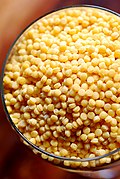
|
Pastina | Small spheres about the same size or smaller than acini di pepe | Little pasta |

|
Pearl Pasta | Spheres slightly larger than acini di pepe | |

|
Puntine | Smaller version of Risi | |

|
Quadrettini | Small flat squares of pasta | Little squares |

|
Risi | Smaller version of orzo | Little rice |

|
Seme di melone | Small seed-shaped pasta | Melon seeds |
| Stelle | Small star-shaped pasta | Stars | |

|
Stelline | Smaller version of stelle | Little stars |

|
Stortini | Smaller version of elbow macaroni | Little crooked ones |
Stuffed pasta
| Image | Type | Description | Translation |
|---|---|---|---|

|
Agnolotti | Semicircular pockets; can be stuffed with ricotta or mix of cheese and meats or pureed vegetables | Diminutive of old word for "angel"; this was Giotto's nickname. |

|
Cannelloni | Rolls of pasta with various fillings, usually cooked in an oven | Big little canes |

|
Cappelletti | Square of dough, filled with minced meat, and closed to form a triangle | Little caps |
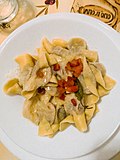
|
Casoncelli or casonsèi | A stuffed pasta typical of Lombardy, with various fillings | Possibly from casa "house" |
| Casunziei | A stuffed pasta typical of the Veneto area, with various fillings | From casa house | |

|
Fagottini | A 'purse' or bundle of pasta, made from a round of dough gathered into a ball-shaped bundle, often stuffed with ricotta and fresh pear | Little cloth bundles |

|
Maultasche | A pasta stuffed with meat and spinach common in southern Germany | Mouth pocket |
| Mezzelune | Semicircular pockets; about 2.5 in. diameter | Half-moons | |
| Occhi di lupo | A large, penne-shaped pasta that is stuffed | Ribbed wolf eyes | |

|
Pelmeni | Russian dumplings (of Tatar origin) consisting of a filling wrapped in thin, unleavened dough | Derived from pel'nyan' (пельнянь) – literally "ear bread" in the native Finno-Ugric Komi, Udmurt, and Mansi languages |

|
Pierogi | Slavic dumplings of unleavened dough stuffed with varying ingredients | Difficult to trace: the specific name pierogi, with its proto-Slavic root "pir" (festivity) and its various cognates in the West and East Slavic languages, shows the name's common Slavic origins, predating the modern nation states and their standardized languages, although in most of these languages the word means pie |

|
Ravioli | Square. About 3x3 cm, stuffed with cheese, ground meat, pureed vegetables, or mixtures thereof | Possibly from rapa, "turnip" |
| Sacchettini | Little sacks | ||
| Sacchettoni | Large little sacks | ||
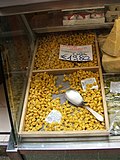
|
Tortellini | Ring-shaped, stuffed with a mixture of meat and cheese | Little pies |
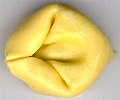
|
Tortelloni | Round or rectangular, similar to ravioli,usually stuffed with a mixture of cheese and vegetables (The term tortelloni is also used for a larger variety of tortellini) | Large little pies |
Irregular shapes
| Image | Type | Description | Translation |
|---|---|---|---|
| Cappelli del prete | Priest's hats | ||

|
Gnocchi | Thick, soft dumplings that may be made from semolina, ordinary wheat flour, flour and egg, flour, egg, and cheese, potato, breadcrumbs, or similar ingredients. | Lumps; may derive from nocchio, a knot in the wood, or from nocca (knuckle), or from gnocco (dumpling). |

|
Passatelli | Formed of bread crumbs, eggs, grated Parmesan cheese, lemon, and nutmeg, and cooked in chicken broth. It is typically found in Pesaro e Urbino (northern Marche) and other regions of northern Italy such as Emilia Romagna | |

|
Spätzle | German egg pasta that is either round in shape, or completely irregular (when hand made) | Means "little sparrow" in Swabian German. |
See also
- Italian cuisine – The cuisine of Italy
- Ragù – a meat-based sauce in Italian cuisine that is often served with pasta
- Semolina – wheat middlings of durum wheat used in making pasta
References
- Marchetti, Domenica (2011). The Glorious Pasta of Italy. Chronicle Books. p. 122. ISBN 1452106908
- The Digital Pasta Book 1 / Italian pasta - H.W. Gade - Google Books
- ^ Definition of spaghetti. Dictionary.com. Dictionary.com Unabridged (v 1.1). Random House, Inc. (accessed: June 03, 2008).
- ^ Why Italians Love to Talk About Food - Elena Kostioukovitch - Google Books
- Encyclopedia of Pasta - Oretta Zanini De Vita - Google Books
- Oretta Zanini De Vita (2009). Encyclopedia of Pasta. University of California Press. pp. 145–147. ISBN 978-0-520-25522-7.
- "Lasagne". Oxford Dictionaries Online. Oxford University Press. Retrieved 18 June 2013.
- ^ 2 Meatballs in the Italian Kitchen - Pino Luongo, Mark Strausman - Google Books
- Cannelloni Recipes Organization. "Cannelloni Recipes". Retrieved 2012-08-26.
- Encyclopedia of Pasta - Oretta Zanini De Vita - Google Books
- Cucina Napoletana - Arturo Iengo - Google Books
- Making Artisan Pasta: How to Make a World of Handmade Noodles, Stuffed Pasta ... - Aliza Green - Google Books
- Slim and Healthy Italian Cooking - Polvay - Google Books
- 365 Ways to Cook Pasta: For Every Season, For Every Reason, a Pasta Lover's ... - Marie Simmons - Google Books
- ^ Naples at Table: Cooking in Campania - Arthur Schwartz - Google Books
- The Food of Campanile: Recipes from the Famed Los Angeles Restaurant - Mark Peel, Nancy Silverton - Google Books
- ^ The Florida Keys Cookbook, 2nd: Recipes & Foodways of Paradise - Victoria Shearer - Google Books
- ^ Joseph Froncioni. "DESIGNERS' PASTA PASTS - Extreme pasta shapes that never made it".
- "RADIATORI". The Geometry of Pasta.
- "The Cook's Thesaurus, Pasta Shapes".
- Kyle Phillips. "Trofie". About.com.
- ^ Eat, Drink, Think in Spanish: A Food Lover's English-Spanish/Spanish-English ... - Lourdes Castro - Google Books
- Paolo Rossi. "The Different Types of Pasta".
- "Merriam Webster". http://www.merriam-webster.com. Retrieved 10 June 2013.
{{cite web}}: External link in|work= - "What the heck is a maultaschen and why would I want to make a casserole out of it?". Retrieved 24 March 2012.
- Encyclopedia of Pasta - Oretta Zanini De Vita - Google Books
- Bella Tuscany - Frances Mayes - Google Books
- Vincenzo Buonassisi, Il nuovo codice della pasta, Rizzoli 1985, recipe #850-853
- Buonassisi, recipe #831-833
- Buonassisi, recipe #837-838
- Buonassisi, recipe #839-840
- Buonassisi, recipe #854-857
- Buonassisi, recipe #877 "Al Pien... si tratta di gnocchi, delicatissimi, secondo un'antica ricetta mantovana..."
- Waverley Root, The Food of Italy, 1971 passim
- Luigi Carnacina, Luigi Veronelli, La cucina rustica regionale (4 vol.), Rizzoli 1966, passim
- Accademia Italiana della Cucina, La Cucina: The Regional Cooking of Italy, tr. Jay Hyams, Rizzoli, 2009, passim
- Oxford English Dictionary, 2nd edition, 1989
- Zingarelli Nicola (2008), Dizionario della Lingua Italiana, Bologna, Zanichelli
- Maria Pia Hellrigl recipe
| Noodles | |||||||||||||||||||||||||||||
|---|---|---|---|---|---|---|---|---|---|---|---|---|---|---|---|---|---|---|---|---|---|---|---|---|---|---|---|---|---|
| Variants |
| ||||||||||||||||||||||||||||
| Dishes |
| ||||||||||||||||||||||||||||
| Instant noodle brands | |||||||||||||||||||||||||||||
| List articles | |||||||||||||||||||||||||||||
| See also | |||||||||||||||||||||||||||||